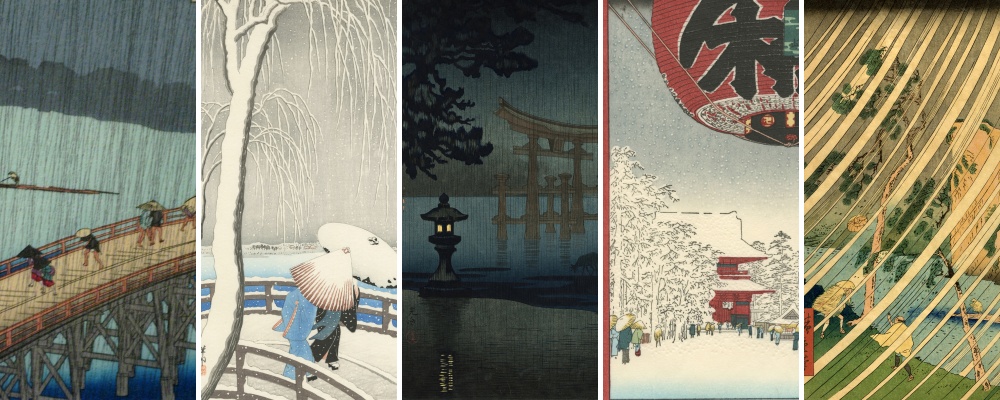Due to forecasted weather conditions, the university has implemented REMOTE STATUS on Friday, December 19, 2025. Students, faculty, staff, see email for more information.
Blog
Ame: Japanese Weather in Woodblock Prints
June 01, 2024

Evening Squall on the Great Bridge in Atake: One Hundred
Famous Views of Edo (no. 52), Woodblock Print, ca 1850. 2007.240.1.
Snow on Willow Bridge, Ohara Koson, Woodblock Print, ca 1927.
2021.33.1935.
Rain in Mitajima, Tsuchiya Koitsu, Woodblock Print, ca 1940.
L11.2022.1039.
Kinryksan Temple at Asakusa: One Hundred Famous Views of Edo (no.
99), Utagawa Hiroshige, Woodblock Print, ca 1930. 2007.239.1.
Mimasaka Province, Yamabushi Valley: Famous Views of the Sixty-odd
Provinces (no. 46), Utagawa Hiroshige, Woodblock Print, 1853,
L11.2022.547.
The islands of Japan receive an abundance of rain throughout the year, with rainy seasons and typhoons prevalent in the summer and fall. The Japanese kanji character for rain is a symbol that dates to Shang Dynasty China (1600-1046BCE). Rain, seen as a critical element for agriculture, was often associated with the power of the gods. In ancient Japan, rain was thought to be controlled by rain deities like Okami or Kuraokami, dragons, and Shinto deities of rain and snow. There have been numerous Japanese poems written about the importance of rain, and there are dozens of words in the Japanese language used to describe different rain and snow situations. Historically, rain has been a common and important theme in Japanese culture, literature, and art (find a poetry example below!).
Ukiyo-e, a traditional form of Japanese woodblock printing, originated during the Edo period (1603-1868CE). Rain, and other forms of weather, were re-occurring subjects for several ukiyo-e artists. While snow may not be as common as rain, most of the Edo period was much colder than temperatures today. This might be one of the reasons depictions of snow also appeared in ukiyo-e landscapes, especially in images of Mt. Atago and the Kan’eiji Temple.
Depicting rain is no easy feat. Many chose to use extremely thin, sometimes crisscrossing black or blue lines, often at an angle across a landscape or other scene. Creating thin lines is a difficult technique in woodblock prints as each line must be carved separately and precisely.
Take a closer look at some of the Japanese woodblock prints in the GVSU Collection. In what other ways is rain or snow conveyed to the viewers?
Utagawa Hiroshige
Artist Utagawa Hiroshige, born Ando Tokutaro, is considered the last great master of the ukiyo-e tradition. He became well known for his large series of prints featuring iconic Japanese landscapes such asThe Fifty-three Stations of Tokaido , and One Hundred Famous View of Edo . He also popularized bokashi, a technique in color gradation that highlighted his subtle use of color.
Explore more artwork by Utagawa Hiroshige.
Ohara Koson
Ohara Koson, born Ohara Matao, was a Japanese painter and woodblock print designer. He was famous for his bird and flower designs known as kachM-e. Throughout his career he created nearly 500 prints.
Tsuchiya KMitsu
Tsuchiya KMitsu moved to Tokyo at the age of 15 to become a student of master woodblock printer Kiyochika Kobayashi. While he originally published prints of the First Sino-Japanese War, he also created many Japanese landscapes. This later work by KMitsu incorporated variations of light into the images unlike many other ukiyo-e artists.
Continue exploring other Japanese prints in the GVSU Collection:
Explore other examples of rain and snow in Japanese prints.
Explore all Japanese prints in the GVSU Collection.
Here’s a translation of a poem, titled “Be Not Defeated by the Rain,” written by Kenji Miyazawa in 1931.
Unbeaten by the rain
Unbeaten by the wind
Bested by
neither snow nor summer heat
Strong of body
Free of
desire
Never angry
Always smiling quietly
Dining daily
on four cups of brown rice
Some miso and a few vegetables
Observing all things
Leaving myself out of account
But
remembering well
Living in a small, thatched-roof house
In
the meadow beneath a canopy of pines
Going east to nurse the
sick child
Going west to bear sheaves of rice for the weary
mother
Going south to tell the dying man there is no cause for
fear
Going north to tell those who fight to put aside their
trifles
Shedding tears in time of drought
Wandering at a
loss during the cold summer
Called useless by all
Neither
praised
Nor a bother
Such is the person
I wish to be
Explore more about Miyazawa’s poem.
